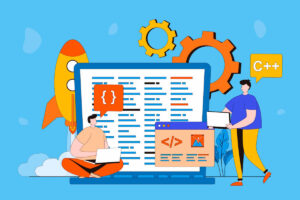Laravel is a powerful PHP framework that has gained popularity among developers for its elegant syntax and robust features. As an advanced developer, it is essential to follow best practices to ensure efficient and maintainable code. In this guide, we will explore some of the best practices for developing with Laravel.
Use the Latest Version of Laravel
One of the most important best practices for Laravel development is to always use the latest version of the framework. The Laravel team regularly releases updates with new features, improvements, and security patches. By using the latest version, you can take advantage of these updates and ensure that your application is secure and up to date.
It is crucial to stay up to date with the latest version of Laravel to leverage new features and enhancements. This not only ensures that your application is using the most advanced technologies but also helps in keeping your codebase secure and free from vulnerabilities. By regularly updating your Laravel installation, you can benefit from bug fixes and performance improvements that can positively impact your application’s performance.
Some benefits of using the latest version of Laravel include improved security measures, enhanced performance, and access to new functionalities that can streamline your development process. Additionally, staying current with Laravel updates allows you to take advantage of community-driven improvements and stay ahead of the curve in terms of web development best practices.
Follow the MVC Architecture
Laravel follows the Model-View-Controller (MVC) architecture, which separates the presentation layer from the business logic and data access layer. When developing with Laravel, it is important to adhere to this architecture to keep your code organized and maintainable. By following the MVC architecture, you can easily make changes to your application without impacting other parts of the codebase.
Adhering to the MVC architecture promotes code reusability, scalability, and maintainability. By separating concerns into distinct layers, developers can work on different aspects of the application independently, making it easier to collaborate and maintain the codebase. Following this architectural pattern also helps in structuring your code in a logical manner, making it easier to debug and test.
Some key benefits of following the MVC architecture in Laravel include improved code organization, easier maintenance, and better scalability. By keeping your codebase organized according to the MVC pattern, you can ensure that your application remains flexible and adaptable to future changes or enhancements. This architectural approach also promotes a clean separation of concerns, making it easier to isolate and fix issues within the application.
Use Eloquent ORM for Database Interactions
Eloquent is Laravel’s built-in ORM (Object-Relational Mapping) that simplifies database interactions by providing a fluent and expressive syntax. When working with databases in Laravel, it is recommended to use Eloquent for querying, inserting, updating, and deleting data. Eloquent allows you to write database queries using PHP syntax, making it easier to work with databases in your application.
Eloquent ORM offers a convenient way to interact with databases in Laravel, abstracting complex SQL queries into simple PHP methods. By using Eloquent, developers can focus on building application logic rather than writing raw SQL queries, leading to more readable and maintainable code. Additionally, Eloquent provides features such as relationship mapping and query scopes, which can streamline database operations and improve code efficiency.
Some advantages of using Eloquent ORM for database interactions in Laravel include reduced development time, improved code readability, and enhanced database abstraction. By leveraging Eloquent’s capabilities, developers can write concise and expressive database queries that are easy to understand and maintain. This ORM also provides built-in support for common database operations, reducing the need for manual query construction and simplifying database interactions.
Implement Authentication with Laravel Passport
Authentication is a crucial aspect of web development, especially when working on applications that require user accounts and secure access. Laravel Passport is a package that provides a full OAuth2 server implementation for Laravel applications. By using Laravel Passport, you can easily implement authentication features such as user registration, login, and password reset functionality.
Laravel Passport simplifies the process of implementing authentication in Laravel applications by providing a robust set of tools for managing user authentication and access control. With features like token management, OAuth2 support, and secure authentication workflows, Laravel Passport enables developers to build secure and reliable authentication systems quickly and efficiently. By integrating Laravel Passport into your application, you can ensure that user data is protected and authentication processes are handled securely.
Some benefits of using Laravel Passport for authentication in Laravel applications include streamlined authentication workflows, enhanced security measures, and simplified user management. By leveraging the features offered by Laravel Passport, developers can focus on building application functionality while delegating authentication tasks to the Passport package. This not only saves development time but also ensures that authentication processes adhere to best practices and security standards.
Write Unit Tests with PHPUnit
Unit testing is a key practice in software development that involves testing individual units or components of code to ensure they function correctly. In Laravel, you can write unit tests using PHPUnit, a testing framework for PHP. By writing unit tests for your Laravel application, you can verify that each component of your code works as expected and catch any bugs or issues before they reach production.
Unit testing with PHPUnit allows developers to validate the behavior of individual components in isolation, ensuring that each part of the application performs as intended. By writing comprehensive unit tests, developers can identify and address bugs early in the development process, leading to more robust and reliable code. Additionally, unit tests help in documenting the expected behavior of code components, making it easier for developers to understand and maintain the codebase.
Some advantages of writing unit tests with PHPUnit in Laravel include improved code quality, enhanced code coverage, and faster bug detection. By incorporating unit tests into the development workflow, developers can identify and fix issues early, reducing the likelihood of bugs and regressions in the codebase. Unit tests also serve as documentation for the codebase, providing insights into the functionality of individual components and ensuring that changes do not introduce unintended side effects.
Optimize Your Application Performance
Performance optimization is essential for ensuring that your Laravel application runs smoothly and efficiently. There are several ways to optimize the performance of your application, such as caching data, minimizing database queries, and optimizing your code. By following best practices for performance optimization, you can improve the speed and responsiveness of your Laravel application.
Optimizing application performance in Laravel involves identifying bottlenecks and implementing strategies to enhance speed and efficiency. Techniques such as database query optimization, caching frequently accessed data, and minimizing resource-intensive operations can significantly improve the performance of your application. By adopting performance optimization best practices, developers can create applications that deliver a seamless user experience and handle high traffic volumes effectively.
Some key methods for optimizing application performance in Laravel include implementing caching mechanisms, leveraging database indexing, and reducing code complexity. By caching data at various levels, developers can reduce the load on the application server and improve response times for users. Additionally, optimizing database queries and structuring code efficiently can help in minimizing resource consumption and enhancing overall application performance.
Secure Your Application with Laravel Security Features
Security is a critical aspect of web development, especially when working on applications that handle sensitive user data. Laravel provides several security features that you can use to secure your application, such as CSRF protection, input validation, and password hashing. By following best practices for security in Laravel, you can protect your application from common security vulnerabilities and ensure that user data is safe.
Securing your Laravel application involves implementing a multi-layered security approach to safeguard against various threats and vulnerabilities. Laravel offers built-in security features like CSRF protection, input validation, and encryption mechanisms to protect user data and prevent unauthorized access. By following security best practices in Laravel, developers can create robust and secure applications that instill trust in users and uphold data privacy standards.
Some security best practices in Laravel include validating user input, implementing secure authentication mechanisms, and regularly updating dependencies to address security vulnerabilities. By validating input data and sanitizing user inputs, developers can prevent common security risks like SQL injection and cross-site scripting attacks. Additionally, implementing secure authentication workflows and encrypting sensitive data can help in safeguarding user information and preventing unauthorized access.
Conclusion
In conclusion, Laravel offers a powerful and feature-rich framework for developing web applications. By following best practices for Laravel development, you can ensure that your code is maintainable, efficient, and secure. In this guide, we have explored some of the best practices for advanced developers working with Laravel. By following these best practices, you can take your Laravel development skills to the next level and build high-quality applications that meet the needs of your users.
FAQs:
1. Why is it important to use the latest version of Laravel?
Using the latest version of Laravel ensures that your application is secure, up to date, and takes advantage of new features and improvements released by the Laravel team.
2. Why should developers follow the MVC architecture when developing with Laravel?
Following the MVC architecture in Laravel helps keep the code organized, maintainable, and allows developers to make changes to the application without impacting other parts of the codebase.
3. Why is it recommended to use Eloquent ORM for database interactions in Laravel?
Eloquent ORM simplifies database interactions in Laravel by providing a fluent and expressive syntax, making it easier to query, insert, update, and delete data using PHP syntax.
4. How can developers implement authentication features in Laravel applications?
Developers can implement authentication features in Laravel applications by using Laravel Passport, a package that provides a full OAuth2 server implementation for user registration, login, and password reset functionality.












+ There are no comments
Add yours